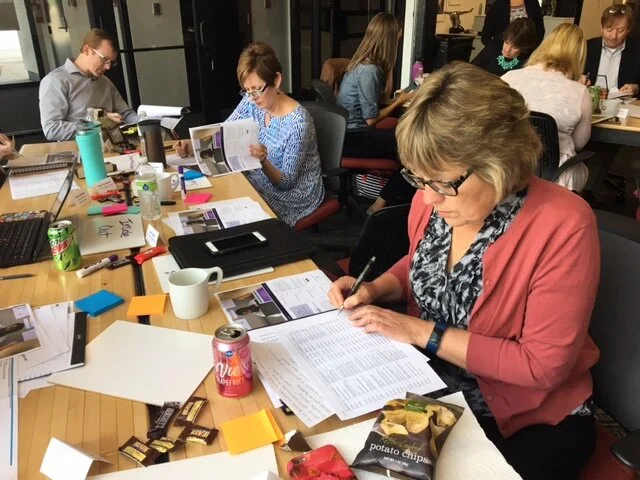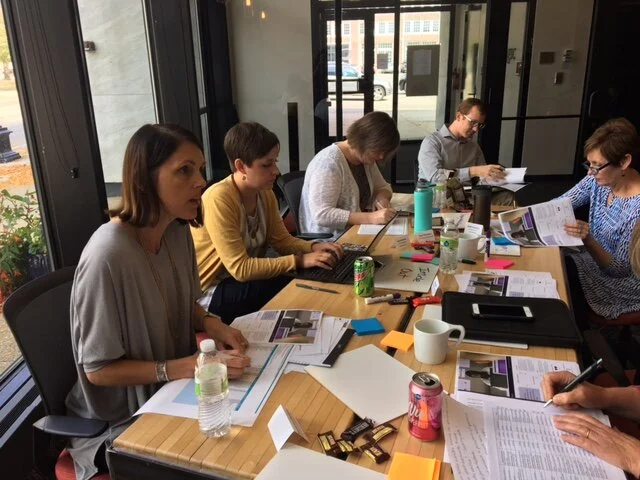Last week, Jenna wrote about decision-fatigue. Decision-fatigue is the “ugh” feeling we’re experiencing while navigating an avalanche of choices. Choosing a return-to-learn plan for my teenagers has been a source of decision-fatigue for my family. Online? Face to face? Hybrid? Virtual Academy? We’re still weighing options and seeking advice. I can’t wait for the “ugh” feeling to be swept away by the “whew” exhale of a choice made!
Read MoreDuring this time of uncertainty these questions can be overwhelming. It becomes easy to reach decision-making-fatigue when we are making choices about the questions, actions, and problems to tackle daily. Yet, there are still decisions to be made and tasks to be completed. Through my recent projects with See What I Mean, I have learned new ways to adapt and cope with decision-fatigue.
Read MoreAt See What I Mean, we are always committed to learning, and we are being intentional about learning how we have benefited from a society based on the premise that white is the norm or standard. We are looking for ways to learn from BIPOC leaders in our community, while also respecting the space they need to grieve and take care of themselves. We have been reading and listening to experts on the topics of racism and anti-racism and want to share some of those resources below.
Read MoreWhen we think about addressing diversity, equity and inclusion (DEI) in our organizations, we tend to jump to the tactical response of training. Training, such as unconscious bias training, is extremely important. However, if we stop there, we might not make lasting or holistic change. Consider, what happens, when we move DEI to the center of the conversation and consider in what ways we need to strengthen, adjust and change all of the ways we work from staffing to planning to partnerships and systems.
When thinking about addressing challenges at the center of our work, See What I Mean often uses a tool called Success Circle.
Read MoreOver the last five years, we’ve seen experts implore organizations to stop strategic planning. The rationale goes… “the world is too unpredictable for long term planning.” Hello 2020! If there was ever a moment to call unpredictable, it’s this one! We’ve never boarded the “stop planning” bandwagon, and we are not going to start now.
Why keep planning?
Read MoreAt See What I Mean, we believe that prototyping plays an integral role in how we think about moving forward with any strategy. However, we also find that the skill of prototyping is one we have to do over and over again in order to engrain it into our standard practices.
Read MorePlan, Act, and Communicate on Multiple Timelines!
Two of the greatest surprises about Thriving in Disruption are:
The need to think and act in at least 3 visions and timelines at once AND
The non-negotiable necessity to prioritize communications that build trust with constituents including donors/partners.
When our current strategies run into disruption we must make choices.
Even during disruption, we have the opportunity to act with intention. Use this model to consider the long-term effects, opportunities and side effects of today’s choices.
Read MoreI was recently in a Zoom meeting and a participant said, “ I don’t know about you all, but when I am in these meetings it is hard for me to believe it is actually real.”
They were talking about the lack of human interaction, but I often have the same thought about virtual meetings when it feels like anything I say just disappears into the ether. I don’t see anyone writing it down, putting it on a
Read MoreToday, many of us are scrambling to find virtual tools for meetings, classes, or to simply stay connected. In response, we've accelerated experimentation with new virtual tools and had to become more systematic to gain confidence to use them with clients.
Read MoreA recent Slate article proposed that the changes we are making to fight COVID-19 will likely mean that we will NOT go back to the “way life was before.” (We’re Not Going Back to the Way Life Was Before, March 12, 2020, Henry Grabar))
In one week in the United States we have accomplished the nearly universal acceptance of social distancing as an effective way to “flatten the curve” and slow down the spread of the virus.
Read MoreLast week, in the midst of making cascading decisions to keep people safe, a client encouraged us to help them find ways to continue planning for the future. Even when their daily work had become exclusively focused on TODAY’S work they were committed to the LONG TERM. It was an important lesson for See What I Mean about leadership, planning and disruption.
Read MoreWe are working on a lot of large and small Virtual Meetings these days, and nothing is worse than holding the time on the calendar and then wasting the time due to technical difficulties. Fortunately, our team has over a decade of telecommuting under our belts, and a wide array of knowledge in over-preparing for meetings.
Read MoreThis week has been a scramble for many of our clients who are canceling in-person meetings as a proactive risk reduction strategy in response to the COVID-19 virus. This isn’t a bad idea, in fact as The Atlantic stated in their byline of the article Cancel Everything, “ Social distancing is the only way to stop the coronavirus. We must start immediately.”
But Wait!
Don’t remove the meeting from your calendar just yet.
Read MoreAs a college student, I have had the opportunity to learn a lot, but I’m trying to figure out how to apply that learning in the real world. Getting the job at See What I Mean has felt like jumping into the deep end of learning how to apply those lessons.
Read MoreI bought a new pair of jeans with very explicit laundry instructions to turn them inside out for washing in order to preserve their full color and quality on the outside.
Read MoreCurrently, my kids are obsessed with the Hamilton soundtrack. After I had the chance to see the play in Chicago, and it lived up to all the hype, I turned on the soundtrack in the car and my son can’t get enough. One song he always asks to play is The Room Where it Happens.
Read MoreDuring one stretch a few years ago, I found myself on 6 Advisory Boards. I love the idea of Advisory Boards — that’s probably why I kept saying yes! You get to be “in the know” of an organization you care about and you get to share some expertise to help. At least that’s what I thought I was going to do when I joined an Advisory Board. Sadly, many Advisory Boards don’t know how to make the most of the of their Advisory Board members. During one particularly long, painful and boring Advisory Board experience I scribbled down some tips of how we can do better. (And, by “we” I mean me included, because I’ve made my fair share of these mistakes during my tenure!)
Read MoreAnyone who cares about a “cause” will do some fundraising at some point. It is inevitable. And most people who give also report that they also fundraise for the things they believe in. But many of us will agree to do fundraising “kicking and screaming” mostly because we feel unprepared and therefore insecure about the task.
But regardless of how we feel about fundraising, nonprofits—large and small—depend on their staff and volunteers to muster their courage every day to ask others to support their cause.
Read MoreTis’ the season to be THANKFUL.
Thankful for our families, our friends, our health, and so on. And in this season of thankfulness, I’m reflecting on one of the biggest network challenges we face today.The challenge is the enormous number of people and organizations wanting to do good. This bounty, if not effectively connected, can make it difficult to impact the world's wickedest problems.
Read More



















